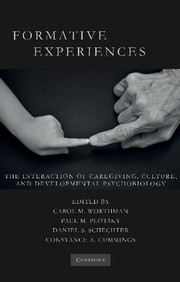Book contents
- Frontmatter
- Contents
- List of Figures
- List of Tables
- List of Contributors
- Foreword by Robert Sapolsky
- Preface
- List of Abbreviations
- Introduction
- SECTION ONE HISTORICAL, CROSS-CULTURAL, AND DEVELOPMENTAL SCIENCE PERSPECTIVES
- SECTION TWO HOW EXPERIENCE INTERACTS WITH BIOLOGICAL DEVELOPMENT
- SECTION THREE FORMATIVE RELATIONSHIPS WITHIN AND ACROSS GENERATIONS
- SECTION FOUR SOCIAL AND CULTURAL CONTEXTS OF CHILDHOOD DEVELOPMENT – NORMATIVE SETTINGS, PRACTICES, AND CONSEQUENCES
- 11 Ethnographic Case Study: Inuit Morality Play and the Danish Medical Officer
- Commentary
- Commentary
- 12 Ontogenetic Perspectives on the Neurobiological Basis of Psychopathology Following Abuse and Neglect
- 13 Ethnographic Case Study: Maria – Cultural Change and Posttraumatic Stress in the Life of a Belizean Adolescent Girl
- Commentary
- Commentary
- 14 Sex/Gender, Culture, and Development: Issues in the Emergence of Puberty and Attraction
- SECTION FIVE FEAR, FUN, AND THE BOUNDARIES OF SOCIAL EXPERIENCE
- SECTION SIX PUBLIC HEALTH, EDUCATION, AND POLICY IMPLICATIONS
- Index
- References
Commentary
Published online by Cambridge University Press: 26 May 2010
- Frontmatter
- Contents
- List of Figures
- List of Tables
- List of Contributors
- Foreword by Robert Sapolsky
- Preface
- List of Abbreviations
- Introduction
- SECTION ONE HISTORICAL, CROSS-CULTURAL, AND DEVELOPMENTAL SCIENCE PERSPECTIVES
- SECTION TWO HOW EXPERIENCE INTERACTS WITH BIOLOGICAL DEVELOPMENT
- SECTION THREE FORMATIVE RELATIONSHIPS WITHIN AND ACROSS GENERATIONS
- SECTION FOUR SOCIAL AND CULTURAL CONTEXTS OF CHILDHOOD DEVELOPMENT – NORMATIVE SETTINGS, PRACTICES, AND CONSEQUENCES
- 11 Ethnographic Case Study: Inuit Morality Play and the Danish Medical Officer
- Commentary
- Commentary
- 12 Ontogenetic Perspectives on the Neurobiological Basis of Psychopathology Following Abuse and Neglect
- 13 Ethnographic Case Study: Maria – Cultural Change and Posttraumatic Stress in the Life of a Belizean Adolescent Girl
- Commentary
- Commentary
- 14 Sex/Gender, Culture, and Development: Issues in the Emergence of Puberty and Attraction
- SECTION FIVE FEAR, FUN, AND THE BOUNDARIES OF SOCIAL EXPERIENCE
- SECTION SIX PUBLIC HEALTH, EDUCATION, AND POLICY IMPLICATIONS
- Index
- References
Summary
As colleagues with different personal and professional backgrounds working together on Inuit mental health research, we found that Jean Briggs's chapter evoked quite different responses. Karla Jessen Williamson is an Inuk anthropologist, Laurence Kirmayer a Euro-Canadian psychiatrist. Our contrasting responses illuminate both the richness and the controversies inherent in Briggs's insightful work and touch on persistent dilemmas in cross-cultural research. In this commentary, we will present some of our respective reflections separately and conclude with some points of convergence.
JESSEN WILLIAMSON: COSMOCENTRISM AND INUIT CHILDREARING
“Naak silavit qeqqa?” This question roughly translates into “Where is the middle of your universe?” My youngest paternal aunt asked me that question in a demanding tone. A totally dumbfounded, awe-struck six-year-old, I was hit by waves of sensation at the prospect of having to locate in my body the very part that housed my intellect, the air that I breathe, and my universe. I looked around at the air surrounding us, seeking the middle of my universe and my intellect; in desperation, I slowly pointed between my eyes! My aunt laughed and laughed. I was never sure whether she took my response seriously, or whether it merely satisfied her need for joking and teasing me.
Sila is the root of the word silavit, and Inuit use it to refer to air, weather, intellect, knowledge, integratedness, wisdom, and the external. MacDonald (1998, p. 35) describes sila as “an indicator of environment, an indicator of locality, and an indicator of intelligence or spirit.”
- Type
- Chapter
- Information
- Formative ExperiencesThe Interaction of Caregiving, Culture, and Developmental Psychobiology, pp. 299 - 307Publisher: Cambridge University PressPrint publication year: 2010
References
- 5
- Cited by



